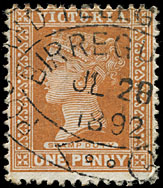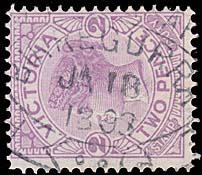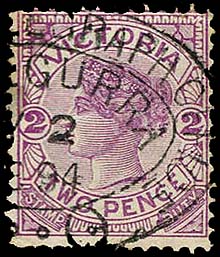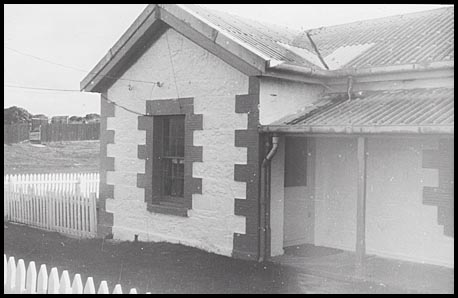Telegraph Offices in the Otways region.
- Home, index, site details
- Australia 1901-1988
- New South Wales
- Overview of NSW
- Telegraph lines
- Telegraph Offices
- Date stamps
- Forms
- Envelopes
- Rates
- Stamps
- Queensland
- Overview of Qld
- Telegraph lines
- Telegraph offices
- Date stamps
- Forms
- Envelopes
- Rates
- Stamps
- South Australia
- Overview of SA
- Telegraph lines
- Telegraph Offices
- Date stamps
- Forms
- Envelopes
- Rates
- Stamps
- Tasmania
- Overview of Tasmania
- General developments
- Reports
- Organisation
- Telegraph lines
- Telegraph Offices
- Date stamps
- Railway lines
- Forms
- Envelopes
- Rates
- Stamps
- Overview of Tasmania
- Victoria
- Overview of Vic.
- Telegraph lines
- Telegraph offices
- Date stamps
- Forms
- Envelopes
- Rates
- Stamps
- Ephemera
- Western Australia
- Overview of WA
- Telegraph lines
- Telegraph Offices
- Date stamps
- Forms
- Envelopes
- Rates
- Stamps
Two of the Telegraph Offices at the beginning of the Cape Otway line - Geelong and Queenscliff were also on the first Victorian telegraph line and so are discussed in their respective entries there.
|
In 1898, the name of the town Krambruk was changed to Apollo Bay after a number of heated public meetings. For example, on 1 April 1898, the Colac Herald reported that the Postmaster-General was asked to change the name because
The name change took place later in 1898. A Post & Telegraph Office opened at Krambruk in about 1885-86 although there were no premises. The Colac Herald of 7 October 1887 reported as follows (repeated in full because of the social commentary included):
The Colac Herald of 3 October 1889 reported that:
In 1890, the Telegraph Office transmitted 1,188 messages and received 1,018 messages. In July 1901, the Postmaster-General threatened to close the Apollo Bay Telegraphic Office due to a lack of staff. The Department had been paying a skilled operator 2s 9d per day for duties of 22 hours per day for 7 days per week. The operator could be called at any time during the night to attend to shipping news. No operator would therefore apply for this position. In August 1904, the oldest resident in the district was about to leave having been transferred to Geelong. Mr Carwood had been in charge of the telegraph lines from Lorne to Cape Otway and from Birregurra to Apollo Bay for over 30 years. The Telegraph Station closed in 1963. |
| Birregurra.
The Geelong Advertiser of 6 December 1873 noted that:
The Telegraph Office was opened in (23?) February 1874 with another office opening on the Railway Circuit in July 1883. A Post Office had been opened on 1 October 1858 but it changed its name to Mount Gellibrand on 15 April 1864. A second Birregurra Post Office was opened on 19 April 1864 in a slightly different location. As an article in The Age (18 May 1874) indicated, the appointment of a female Post and Telegraph Mistress to Birregurra was fortunate because not only was there "the opportunity of earning a respectable maintenance for themselves and the families dependent upon them, but a considerable saving has been effected" due to the much lower salaries paid to women. |
||
The Office was issued with a 2 hole Belt & Buckle date stamp.
|
 28 July 1892. |
 18 January 1893. |
 |
||
|
||
| Cape Otway.
The Telegraph Office opened in September 1859. It was a critical point in the surveillance of shipping along the Victorian coast - especially in times of difficulty or distress.
(The Argus, 25 April 1861, p. 5). The office became of critical importance when the first cable was laid between Tasmania and Victoria in 1869. In January 1886, a major bush fire threatened the lighthouse but the buildings were saved "by all hands fighting the fire". The danger did not however pass as the fire then moved on to Apollo Bay fuelled by a strong north-easterly gale. Some tales of incidents at Cape Otway are included elsewhere. |
|

|
 The Telegraph Office at Cape Otway from the rear. |
| The Cape Otway region was thick with forests and was considered to be rich in gold. The Argus of 1 April 1868 reported that the township of Camperdown contributed to pay the expenses of a prospecting party consisting of six experienced miners for ten weeks to prospect for gold in the neighborhood of Cape Otway. " That there is gold in the Cape Otway forests there is no doubt".
An interesting newspaper article on Holiday Rambles to Cape Otway was published in the Illustrated Australian News for Home Readers published on 31 December 1873. |
 Photograph by Roger Holdsworth. Source: State Library of Victoria H201290/47. |
| No special date stamp was issued to Cape Otway for use with telegraphic work. Instead the usual postal date stamp was used.
Unframed date stamp for usual postal use. Diameter: 24 mm. |
 14 November 1921. |
| Newport.
The Telegraph Office opened in April 1862 on the Railway Circuit. By 1890, there was a major test box used at Newport. |
|
The Geelong Advertiser of 6 December 1873 noted that:
The Telegraph Office opened on 25 February 1874 and opened on the Railway Circuit in August 1878. As an article in The Age (18 May 1874) indicated, the appointment of a female Post and Telegraph Mistress to Winchelsea was fortunate because not only was there "the opportunity of earning a respectable maintenance for themselves and the families dependent upon them, but a considerable saving has been effected" due to the much lower salaries paid to women.
|

